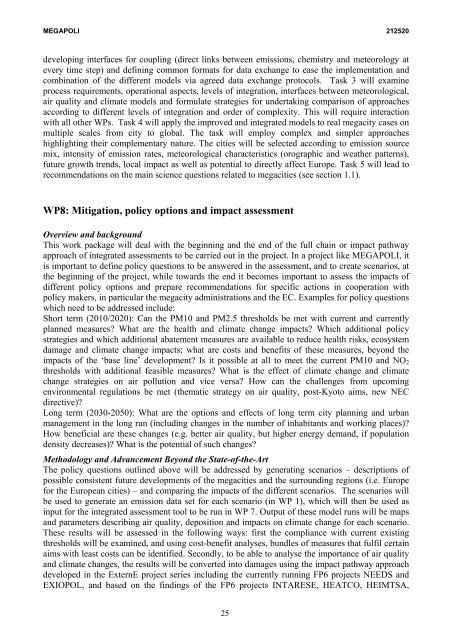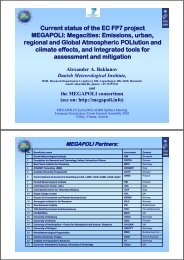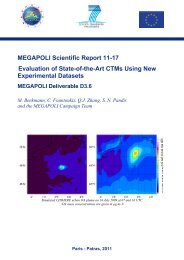D E S C R I P T I O N O F W O R K - MEGAPOLI - Dmi
D E S C R I P T I O N O F W O R K - MEGAPOLI - Dmi
D E S C R I P T I O N O F W O R K - MEGAPOLI - Dmi
Create successful ePaper yourself
Turn your PDF publications into a flip-book with our unique Google optimized e-Paper software.
<strong>MEGAPOLI</strong> 212520<br />
developing interfaces for coupling (direct links between emissions, chemistry and meteorology at<br />
every time step) and defining common formats for data exchange to ease the implementation and<br />
combination of the different models via agreed data exchange protocols. Task 3 will examine<br />
process requirements, operational aspects, levels of integration, interfaces between meteorological,<br />
air quality and climate models and formulate strategies for undertaking comparison of approaches<br />
according to different levels of integration and order of complexity. This will require interaction<br />
with all other WPs. Task 4 will apply the improved and integrated models to real megacity cases on<br />
multiple scales from city to global. The task will employ complex and simpler approaches<br />
highlighting their complementary nature. The cities will be selected according to emission source<br />
mix, intensity of emission rates, meteorological characteristics (orographic and weather patterns),<br />
future growth trends, local impact as well as potential to directly affect Europe. Task 5 will lead to<br />
recommendations on the main science questions related to megacities (see section 1.1).<br />
WP8: Mitigation, policy options and impact assessment<br />
Overview and background<br />
This work package will deal with the beginning and the end of the full chain or impact pathway<br />
approach of integrated assessments to be carried out in the project. In a project like <strong>MEGAPOLI</strong>, it<br />
is important to define policy questions to be answered in the assessment, and to create scenarios, at<br />
the beginning of the project, while towards the end it becomes important to assess the impacts of<br />
different policy options and prepare recommendations for specific actions in cooperation with<br />
policy makers, in particular the megacity administrations and the EC. Examples for policy questions<br />
which need to be addressed include:<br />
Short term (2010/2020): Can the PM10 and PM2.5 thresholds be met with current and currently<br />
planned measures? What are the health and climate change impacts? Which additional policy<br />
strategies and which additional abatement measures are available to reduce health risks, ecosystem<br />
damage and climate change impacts; what are costs and benefits of these measures, beyond the<br />
impacts of the ‘base line’ development? Is it possible at all to meet the current PM10 and NO2<br />
thresholds with additional feasible measures? What is the effect of climate change and climate<br />
change strategies on air pollution and vice versa? How can the challenges from upcoming<br />
environmental regulations be met (thematic strategy on air quality, post-Kyoto aims, new NEC<br />
directive)?<br />
Long term (2030-2050): What are the options and effects of long term city planning and urban<br />
management in the long run (including changes in the number of inhabitants and working places)?<br />
How beneficial are these changes (e.g. better air quality, but higher energy demand, if population<br />
density decreases)? What is the potential of such changes?<br />
Methodology and Advancement Beyond the State-of-the-Art<br />
The policy questions outlined above will be addressed by generating scenarios – descriptions of<br />
possible consistent future developments of the megacities and the surrounding regions (i.e. Europe<br />
for the European cities) – and comparing the impacts of the different scenarios. The scenarios will<br />
be used to generate an emission data set for each scenario (in WP 1), which will then be used as<br />
input for the integrated assessment tool to be run in WP 7. Output of these model runs will be maps<br />
and parameters describing air quality, deposition and impacts on climate change for each scenario.<br />
These results will be assessed in the following ways: first the compliance with current existing<br />
thresholds will be examined, and using cost-benefit analyses, bundles of measures that fulfil certain<br />
aims with least costs can be identified. Secondly, to be able to analyse the importance of air quality<br />
and climate changes, the results will be converted into damages using the impact pathway approach<br />
developed in the ExternE project series including the currently running FP6 projects NEEDS and<br />
EXIOPOL, and based on the findings of the FP6 projects INTARESE, HEATCO, HEIMTSA,<br />
25




